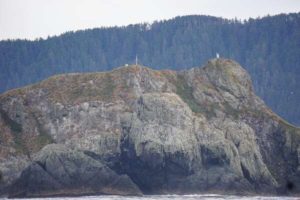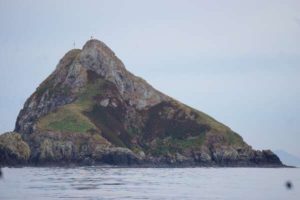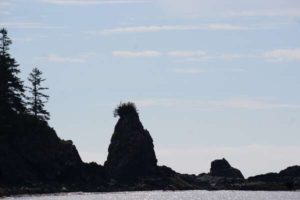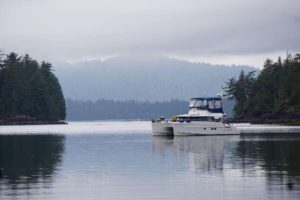Bunsby Islands southeast of Brooks Peninsula, 7-Sep-2018 — The random play on the tablet seems to have a penchant for 1960’s seminal bands: The Byrds, the Yardbirds to name two.
We’re in a cove nestled away from the Pacific, which won’t be very pacific for the next few days. Today is not too bad, twenty knots most of the day, but a low is moving in. The barometer will drop from 1018 to 996 in a bunch of hours at some point in the next couple, three days and 40 knot winds are scheduled to come ashore.
The place Jennifer had chosen from a chart was occupied by L’Excursion a Fountaine-Pujot 37-foot Trawler Motor Cat that we have been criss crossing paths with for the last few days.
Instead, Jennifer put us forward in the cove against the trees, anchored fore and aft. The trees protect us from the strength of the wind, but it still makes me nervous. The drag alarm, which I set very tight, just went off. All looks fine. We can only move side-to-side at a right angle to the line between the two anchors. I try to figure out whether the stress on the anchors is less if there is more or less slack. Any math majors or mechanical engineers who can answer the question?
Until yesterday, there had been no wind. We’ve motored, solely, in the Pacific. It has made me less happy, as I would prefer to sail. The water was mostly hammered metal forming the shapes the northwest native people base their art on. Now that we’ve made the connection, we can never not see it.
As we arrived, yesterday, there was enough wind to move under sail, but weather paranoia had started to build, and we wanted to get settled.
We have had the main sail up everyday: We’ve been pretty much at right angles to the swell. The main acts as strong and effective riding sail. The motoring was smooth, if nothing else.
A week or so ago in Khutze Inlet, I watched someone’s dog walk confidently along the spit dragging something limp, long and black, between its legs. The dog would stop, get a better grip and and continue on. With binoculars, I could not find owner, who was probably on the far side of the spit.
In Khutze Inlet, the spit and several acres of lowland is covered at high tide. Entering, the inlet is open and clear ending in green land with a creek at the left. The tides are more than twenty feet. Anchoring in 20 feet at high tide can yield a nasty surprise.
Within a few moments, it was clear there was no owner and this was a brown wolf, very brown, with no gray, black or blonde. What was it carrying? With silhouetted light, it was difficult to tell. Jennifer thought it was perhaps a bald eagle. At low tide, the uncovered land is populated by bald eagles. But dead birds are floppy with wings askew.
As the wolf walked along the spit a second wolf appeared: the mate.
The mate walked along side, kept watch, walked ahead and waited, but always escorted the wolf with the kill.
What struck me more than anything is how absolutely confident these two wolves were. Not cocky, not proud, not the walk of an athlete, or the confident walk of someone who knows they are being watched and exudes confidence.
This was internal confidence about all aspects of their existence.
The mate lay down at the top of a gulley while the wolf with the catch carried it through. Once at the top of the gully, they were no longer against the light: the hunter had taken a seal pup.
The wolves walked easily, with a natural stride. I expected the paws to flip forward at they walked, but the paws we always forward. The walk was a walk, not prance, nor trot, not a lope: a walk. The pair were as comfortable with each other as they were individually.
Their route took them into the tall grass. We could, for a while, see their heads appear and disappear. It was apparent they took breaks and rested. We never saw them roles switch. The hunter always carried the kill. Nor did they start to eat the kill.
We assumed that the seal pup was going back to the den and wolf pups.
In a 20-foot RIB, talking with a large trawler was the skipper of the 78′ foot schooner, Ocean Light II. We had seen the schooner last year waiting for new guests in a bear sanctuary.
The skipper motored over to us and spoke with us for a while. He makes morning rounds of the boats anchored with him. Like many Canadian vessels, he doesn’t use AIS, so we can’t see him electronically, nor he us.
He told us we had shared Bag Harbour on Haida Gwaii with him waiting out weather. He told us that we get around. We were flattered to be remembered, since he had to remember us by sight.
The boat was made in South Hampton UK and was one of four made.
Canadian charter boats no longer leave Canada. They once did, but the hassle of getting into the US isn’t worth it. We heard this again and again. We also heard the same thing from American charter boats: Getting back into the states after leaving just isn’t worth the effort of leaving.
In 2016, a CBP man in Wrangle told me that things had changed and it was by the book. A cruise ship coming into wrangle from Canada could take three hours to clear people, so most people didn’t bother to get off anymore. Most of the large cruise ships we met in Alaska went directly from Seattle to AK without a stop. There were ships that left from Vancouver, but if it is like the airlines, US customs happens before the ships depart.
After the wolves were gone a while, a brown bear cantered across the grass onto the spit and into the water. His behavior made us guess he was an adolescent. Chasing seagulls through the water and bounding onto the beach wasn’t going to catch dinner. He continued his exertions as we weighed anchor and motored out.
The west coast of Vancouver Island is as rocky as we remembered, but that memory was in terms of doubts that it could be that rocky.
Rock islands rise from the water. Only the largest have vegetation beyond shrubs. What appear to be the rocks and islands we have seen the last three years are instead hundreds of feet tall and rise vertically with nowhere for a boat to land.
The swells are ocean swells. A two-meter swell, with no wind, is languid, reminding me of the earthquake waves in an open street: the entire basis of one’s attachment to the earth rises and rolls by. As the swell near the shallows, they do not lessen in height, but bunch up becoming steeper. With a few feet of wind wave, the picture is no longer languid, but inspires concentrated consideration.
Crossing a shallows or bar, the swells have lose their power. The wind generally loses strength close to the coast. We noticed that the Weather Canada forecast winds were always 17 miles offshore, according to the GRIB files, except the coming winds, which are forecast to be stronger on the coast than offshore.
Jennifer reads a book about a ferry lost on Lake Huron in the early twentieth century. I have bread in the oven and pea soup finishing. The wind in our rigging is loud: it is the sound effects that we hear in every disaster-at-sea movie, but in our rigging the sound starts at a gentle ten knots. It is something we hear but don’t attach much to, except when we know strong winds are on their way.
Four days to relax, be together, read, cook, write and yes, clean and do maintenance and wait for better weather.
Thanks for reading.
Sent from Iridium Mail & Web.




